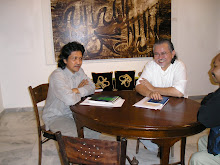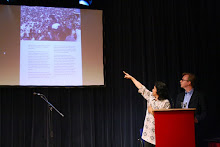In February 2008 Emha was invited by the British Ambassador, Charles Humphrey, to attend and speak at the opening of a photographic exhibition in Yogyakarta, Central Java, of works by British Muslim photographer Peter Sanders. This is the essay he wrote for that occasion.
In my iPhone 1.1.3 I have saved a directory that consists of photos by Peter Sanders, which I deliberately mixed with photos of my wife and children. When I had a moment, I made a slide show of the pictures that – in the language of Islam: were full of the colours of the divine. First among the colours represented was blue with purple, which, according to those endowed with “knowledge of the spiritual world”, are the colours of God’s Heavens, inhabited by the Angels and spiritual beings. So they say.
Just as I see my children, wife and family in a sacred place within myself, so do I sense the energy and frequency in the soul of Peter Sanders. These photos are one form of the material output of inner-energy and the inner-frequency of his soul. In all honesty, this ‘inner space’ of the soul has throughout history given birth to some of the most important values of humanity: culture, democracy, nationhood, wisdom and knowledge, love, multi-culturalism and the combination of those components of society and the well-learned lessons of history that lead us to gather together in this place today, in this spirit of shared happiness and optimism.
I don’t know. But I am sure that photography is not at all about the technology of taking pictures, art or the visual industries. I worry that if photography is viewed merely as a means of recording pictures, it ignores its prime domain, wherein the photographer attains the peak of his experience and existence by “illustrating” the creativity of his inner self. It is possible that his career as a photographer may not be his most important role because he will have entered and encountered a host of values that are far broader and deeper than his social role as a photographer.
Perhaps we aim to depict because we seek. We write poetry, arrange music, paint, move and dance or through whatever forms and means of expression we choose: because we seek. It is possible that the entire culture of humanity through the ages has developed in response to our seeking; our never-ending seeking. For what do we forge nations, organise, form companies, develop industry and technology to the best of our utmost abilities, when our primal drive is that we seek?
And perhaps we can agree that what we truly seek is the essence of our own selves. Many people come to laugh in their old age, because for decades they have believed that their social identiy was “themselves”: that their positions, awards, even their faces and the shapes of their bodies, is somehow “themselves”. Peter Sanders is in a perpetual “flight”; not merely moving in a geographical sense but also in depicting value after value, dimension after dimension, nuance after nuance, heaven after heaven. Surely, in some instinctive or rational way, he has touched upon and understood who he is, and he walks on in the world among the values of life, recognising himself again in a speck of dust, in every particle of earth, in every leaf and in every breath of wind.
I believe that if Peter were to portray a human face, it would not merely be the form of the face that he would depict. The same is true for a mosque, the expression of the ageing process, children learning or any other object you could name. It is not the object “itself” that he portrays, because that which portrays is not merely the eye and camera of Peter Sanders. His eye, hand and camera are merely directed by “the essential Peter Sanders”, which exists far inside the inner being of Peter, and which we can encounter through this exhibition. “The essential” is what we call the spirit, aspirations, inner-creativity, heart and soul.
The temple of Borobudur, near Yogyakarta, depicts three states of being. The first, and lowest, is the world of desires, or “kama duta”. The second, and middle, is the world of forms or “rupa datu”. Finally, the third, and highest, is the formless absence of desire; nirvana or “arupa datu”. Peter’s work, while located within the world of forms, allows us to view glimpses of nirvana.
Now we can see, enjoy and wonder at the photos, colours, lines and the forms depicted within the frames – these open the doors to meeting with the essential self of the man, Peter Sanders. With our eyes we view the results of his photography, but what is depicted by Peter Sanders cannot be encountered by the eye. If we use the familiar idiom of Indonesia: Peter portrays with his “inner eye”, and we enjoy his photography through our own.
Yogyakarta, Indonesia, 17 February 2008
Emha Ainun Nadjib
Translated by Ian L. Betts
Saturday, 15 August 2009
Subscribe to:
Post Comments (Atom)


.jpg)





No comments:
Post a Comment